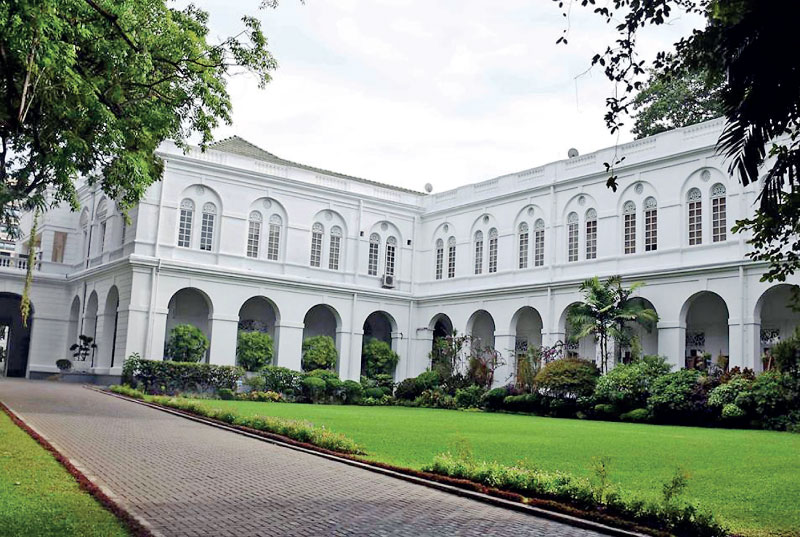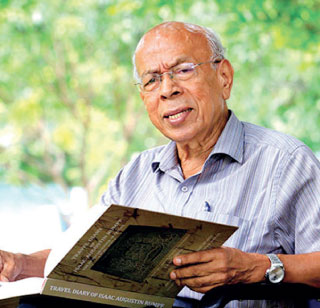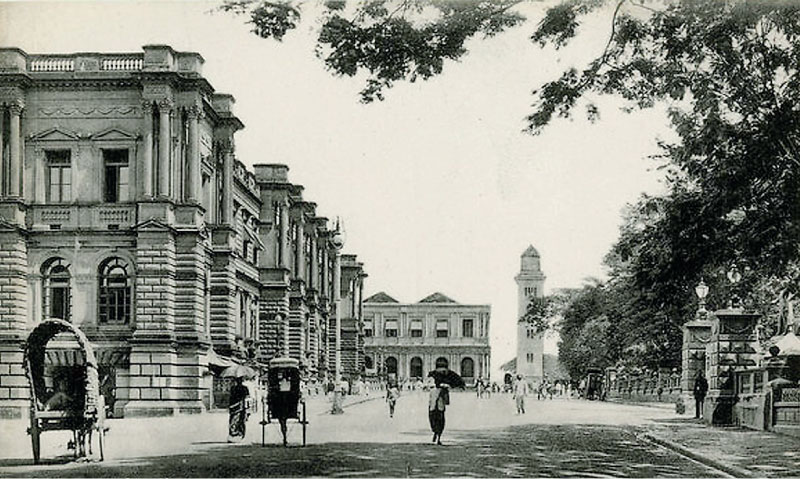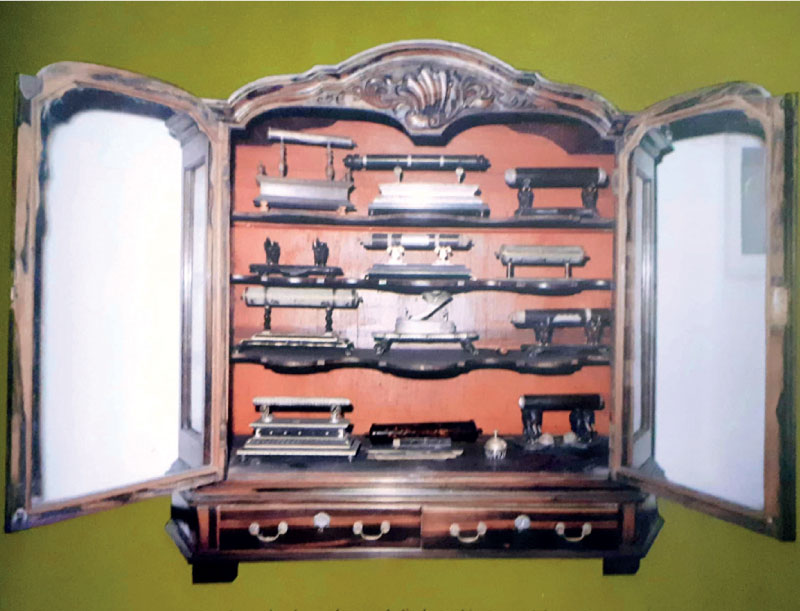Wednesday Jan 14, 2026
Wednesday Jan 14, 2026
Wednesday, 20 July 2022 01:06 - - {{hitsCtrl.values.hits}}

The stately mansion which is an archaeologically protected monument
More than two centuries old landmark of Colombo – President’s House in Fort or ‘Raja Gedera’ as referred to in common parlance regained international spotlight a few weeks ago as it was stormed by protestors.
Centuries-old artefacts and paintings were vandalised and some looted to the dismay of heritage lovers. While some walls of this archaeologically important edifice were soiled with graffiti, floors were dented by those on the hunt for hidden passageways. The damage caused to this archaeologically protected monument is colossal.
From the residence of a Dutch Governor to President’s House, the evolution of this mansion of historical significance is an eventful one. Daily FT looks back at its early days when it earned the reputation of being ‘the largest and best dwelling house in the Fort of Colombo’
By Randima Attygalle
 |
| Prof. K.D. Paranavitana |
 |
| A magnificent calamander wood cabinet in the President’s House |
 |
| Last Dutch Governor Johan Gerard van Angelbeek who first built the Governor’s House
|
The last of the Dutch Governors of then Ceylon – Johan Gerard van Angelbeek built a house on the site where the President’s House stands today. When van Angelbeek built his residence the British were already here. Historian R.L. Brohier in his work ‘Changing Face of Colombo’ notes that the Dutch Governor ‘continued to live in Colombo under the British protection with a hierarchy of servants’. When Governor Angelbeek died in September 1799, his property passed over to his son Christianne.
James Cordiner in his compilation ‘A Description of Ceylon’ documents the funeral procession of Governor van Angelbeek and events which followed on 3 September 1799 as follows: “Having paraded by torchlight through the streets of Colombo in procession and seen the body of the former Governor deposited beside that of his wife in the family vault, the mourners repaired to the house of the deceased, where a large party of ladies was assembled and the rooms were soon crowded with a mixture of all nations, who spent the evening in drinking various liquors and smoking tobacco.” Cordiner goes on to describe the house as ‘the largest and best dwelling-house in the fort of Colombo and is now occupied by Major-General Right Hon. Thomas Maitland, governor of the island.’ He further writes that the house was situated in the ‘principal street and composed of two regular stories. From the upper balcony on one side is an extensive view of the sea, the road, and shipping. On the other is a richer prospect, comprehending the lake, Pettah, cinnamon plantations and a wide range of the inland territories bounded by Adam’s Peak and many lesser mountains.’
Acquisition by the British government
Brohier in ‘Changing Face of Colombo’ goes on to write: “Among the earliest arrivals of younger sons of English noble families to Ceylon was George Melville Leslie, a son of a 6th Earl of Leven, who is mentioned as having been Paymaster General in 1802. Having married the Dutch ex-Governor’s granddaughter, Leslie came to be associated with the Angelbeek family. A year after the marriage a deficit of one hundred thousand Rix-dollars (ten thousand pounds) was disclosed in Leslie’s accounts. When Governor Angelbeek died in September 1799, his property passed over to his son Christianne who came to the rescue of his niece and her husband. He generously offered to hand over the family house as part payment of the losses to the Government as a result of Leslie’s conduct. Fredrick North, the British Governor at the time who evidently thought that the delinquent should not be harshly treated, accepted the offer.” Thus, in 1804 the house became the property of the British Government.
The building then came to be occupied by Major General Hay Macdowall who commanded the British troops. The ground floor of the building had two reception rooms spacious hall 300 feet in length. “This was where Council meetings were held where Ambassadors from the kings of Kandy had laid presents they brought and were entertained,” documents Brohier. The writer goes on to mention that the Dutch Governors also held levee there.
An 18th century painting in the Rijks Museum in Netherlands according to the historian, depicts a ‘sunken-garden elegantly landscaped and pleasing to the eye’ located below the southern face of the building. The garden could be accessed by a flight of steps from the verandah of ‘The Government House’ and ‘there is said to have been a tower in which a bell was hung and the hours struck by the garrison.’ The garden was subsequently drained and filled up.
Macdowall who complained that the house was ‘old and leaked badly’, demolished the flat-roofed upper floor and alterations were made ‘in quasi-classical architecture – essentially British’ as Brohier describes.
Feminine influence and festivity
When General Macdowall left the island in 1804, the house came to be occupied by the Ceylon’s second British Governor – Sir Thomas Maitland. “Lady Brownrigg, wife of Maitland’s successor – the 53-year-old Sir Robert Brownrigg, appears to have brought a feminine influence into the old house for the first time after many years when she entered it with her husband in 1812,’ notes Dr. Brendon Gooneratne in his illustrated volume – ‘From Governor’s Residence to President’s House’. Lady Brownrigg who indulged in entertaining is said to have given a ‘Rout’ at Government House on 18 January 1813 and attended an ‘al fresco’ ball and supper given by the ‘bachelors of the 4th Ceylon Regiment’ says Dr. Gooneratne in his work.
Governor’s House became a hive of activity and festivities during Sir Edward Barnes who succeeded Brownrigg. Citing a historian in his compilation, Dr. Gooneratne writes, “Barnes lived more luxuriously than a Park Lane millionaire. He furnished himself with residences all over the island. He built for the use of the Governor, Barnes Hall in Nuwara Eliya and the Pavilion at Kandy. (President’s Cottage and President’s House Kandy today).” One Mrs. Smith of Baltiboys, as Dr. Gooneratne refers to in his book, who dined at the Governor’s House on every evening except two, during her three-week visit to Ceylon was shocked by the doings there which she considered ‘certainly extraordinary’. The fancy dress ball described by Mrs. Smith is probably the Shakespearian fête mentioned in the Government Gazette which was given at the mansion on 1829 ‘in commemoration of the birth of His Excellency the Governor’s daughter’ says the writer.
Gooneratne goes on to note that by the time Bishop Reginald Herber and his wife visited Sir Edward Barnes and Lady Barnes in Colombo, their residence was unofficially titled ‘King’s House’. A statue of Barnes which was erected outside the Governor’s House in 1847 still stands tall today.
Royals at the Queen’s House
The governor’s residence was named ‘Queen’s House’ with the accession of Queen Victoria to the throne in June 1837. It was the final year of the administration of Governor Sir Wilmot Horton and extensive repairs were done during the last two years of his regime when ‘the greatest part of King’s House was taken down and rebuilt’. Again in 1852, it had been ‘practically rebuilt by Durand Kershaw, Assistant Civil Engineer, at a cost of £ 7,000’, according to the ‘History of the Public Works Department (1921-3)’ by P.M. Bingham.
The first visit by a member of the Royal family to the Queen’s House was in 1870 by Alfred, Duke of Edinburgh, second son of Queen Victoria. Governor Sir Hercules Robinson put on a dazzling show for the Prince and his party. The reception held at Queen’s House was reported to be ‘the most brilliant and numerously attended of any that had ever been held in Ceylon.’
The second royal visit was by the Prince of Wales (later King Edward VII) who came in 1875 and was the guest of Governor Sir William Gregory. Governor Gregory writes in his autobiography: “I was surprised and elated by its size and grandeur. The bedrooms large and airy, each with its own bath, large enough to swim in; the drawing room seventy-five feet long, looking out on the sea and on a garden, in which were growing trees all decked out with flowers, some of them most gorgeous, such as I had never seen before – Barringtonia, with its grand leaves and showers of white flowers; the pandanus, a towering banyan and innumerable others… The house was lighted up and furnished at Government expense.”
Dr. Gooneratne in his book writes that before Governor Robert Chalmers left Ceylon in 1916, he called a conference of educationists at Queen’s House in November 1915. “Chalmers was a distinguished classical scholar who had strongly encouraged proposals for the establishment in Ceylon of a university college, to be enlarged later into a full-scale university.”
Sprawling gardens and breathtaking vistas
Queen’s House which witnessed Governor Sir John Anderson’s funeral there in 1918, was privy to the wedding ceremony of Anderson’s successor Sir William Manning who married a South African heiress Olga Sefton-Jones in December, 1919. The distinguished visitors to the Queen’s House on numerous occasions were many including royals, authors, artists, diplomats and many more. Arnold Wright in ‘Twentieth Impressions of Ceylon: Its History, People, Commerce, Industries, and Resources’, provides a detailed description of the interior of the mansion: “Between the ballroom and the drawing-room at one end is the billiard room and at the other end are bedrooms and a corridor leading to the north wing, wherein are situated the State bedroom and dressing room. These are large airy rooms from which excellent views are obtainable…the gardens which over eight acres surround the house and in most directions views of the sea are to be had.”
President’s House
In 1925 the Queen’s House had become unsafe and as Dr. Gooneratne records, “A press communiqué announced that no reception of any magnitude could be held on the State Ball Rooms or the Reception Rooms.” Thus the succeeding governors all made ‘Temple Trees’ their residence while the Queen’s House was occupied by several government offices. The Queen’s House came to be occupied by Sir Oliver Goonetilleke as the first Ceylonese Governor General in 1954, followed by William Gopallawa. In 1972 when Ceylon became Sri Lanka, ‘Queen’s House’ was renamed as ‘President’s House’ with the naming of William Gopallawa as the first President of the new Republic. When J.R. Jayewardene assumed duties as Sri Lanka’s first executive President, this splendid mansion which withstood many winds of change was restored to its former grandeur and was used for official functions and affairs of state.
An archivist recollects
Prof. K.D. Paranavitana, a historian and an authority on the Dutch rule in Sri Lanka, served in the President’s House as an Archivist for a number of years. “In December 1977, the prospective occupant of the President’s House, J.R. Jayewardene who was then the Prime Minister, made an unscheduled visit to the National Archives in Colombo where he discussed his intention of establishing a Presidential Archives. This surprise but meaningful visit gave birth to a new institution for preserving the memory of the documented past for the benefit of posterity.”
The first location of the Presidential Archives was the record room area of the south wing of the President’s House. “At the very outset President Jayewardene handed over his entire private collection of manuscripts and books which until then housed at his residence in Ward Place. Incidentally, I was appointed in charge of the Presidential Archives having the staff and office in the same premises in 1978.”
President Jayewardene’s records included ‘Public Records’ (and they are unequivocally and irrevocably the property of the State) and his private records on many subjects. “All these archives located in the President’s House were later shifted to the Chamber area of the old Parliament building in Galle Face after completion of its repairs by the Mitsui Construction Company in 1983, recollects the historian.
“The most dazzling event I experienced at the President’s House was the visit and the stay of Queen Elizabeth II, Prince Philip and their Royal Party when they arrived here in connection with the celebrations of the 50th anniversary of the Universal Suffrage in 1981 and the inauguration of the accelerated Mahaweli Project,” remarks Prof. Paranavitana.

General Post Office and the Queen’s House from yesteryear

A sketch of the Old Government House as it was then known in the early years of the British rule

A calamander wood cabinet with scrolls found in the President’s House
Photo credit –
"From Governor’s Residence to President’s House",
by Brendon Gooneratne